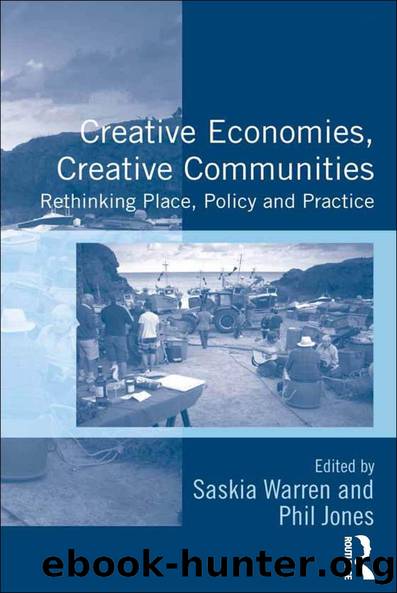Creative Economies, Creative Communities by Saskia Warren Phil Jones

Author:Saskia Warren, Phil Jones [Saskia Warren, Phil Jones]
Language: eng
Format: epub
Tags: Business & Economics, Development, General, Political Science, Public Policy, Cultural Policy, Science, Earth Sciences, Geography, Social Science, Anthropology, Cultural, Cultural & Social, Human Geography, Popular Culture
ISBN: 9781472451385
Google: eHTasgEACAAJ
Publisher: Ashgate Publishing Company
Published: 2015-09-28T06:01:35+00:00
Annex: Policy Proposals from the Creative Participation Project
1. Communities should be encouraged and supported to engage both in conventional consultation processes and through more creative mechanisms, including theatre, film, cartoons, music and art;
2. Both elected representatives and employees in local government should work with communities proactively. Officers should not become a hidden hurdle to reform;
3. Planning use classes should differentiate between socially and culturally beneficial uses and those that pursue solely economic aims. Local, place-based concerns should be capable of being âmaterial considerationsâ under planning law;
4. Outline planning permission should incorporate some commitments to principles of internal design rather than focusing solely on the size and location of the development;
5. Criminal laws and planning rules should not be used to stop bottom-up improvement of areas. Local communities should be able to adorn their environments â through planting, art and signage â without the consent of the local authority;
6. Support, both financial and logistical, should be made available to enable communities to see examples of good practice elsewhere;
7. The new neighbourhood planning proposals need to engage with the multiplicity of communities. There are many publics and communities that all need to be engaged, including more marginalised groups. This will require time and resources. Bottom-up initiatives need support if they are not to become simply a base for the most vocal;
8. Conventionally unrepresented groups, particularly socially and economically disadvantaged young people, can be engaged through more creative mechanisms such as music and art. This builds individual confidence and strengthens links with the local community and other related groups;
9. Communities often become most engaged in positive projects rather than critiques of existing policies. This requires some funding as well as access to expertise. It is more productive than a negative critique of planning applications and the scrutiny of planning documents.
Download
This site does not store any files on its server. We only index and link to content provided by other sites. Please contact the content providers to delete copyright contents if any and email us, we'll remove relevant links or contents immediately.
Man-made Catastrophes and Risk Information Concealment by Dmitry Chernov & Didier Sornette(4728)
The Revenge of Geography: What the Map Tells Us About Coming Conflicts and the Battle Against Fate by Kaplan Robert D(3596)
Zero Waste Home by Bea Johnson(3285)
COSMOS by Carl Sagan(2944)
In a Sunburned Country by Bill Bryson(2941)
Good by S. Walden(2909)
The Fate of Rome: Climate, Disease, and the End of an Empire (The Princeton History of the Ancient World) by Kyle Harper(2429)
Camino Island by John Grisham(2379)
A Wilder Time by William E. Glassley(2358)
Organic Mushroom Farming and Mycoremediation by Tradd Cotter(2304)
Human Dynamics Research in Smart and Connected Communities by Shih-Lung Shaw & Daniel Sui(2174)
The Ogre by Doug Scott(2105)
Energy Myths and Realities by Vaclav Smil(2054)
The Traveler's Gift by Andy Andrews(2007)
Inside the Middle East by Avi Melamed(1937)
Birds of New Guinea by Pratt Thane K.; Beehler Bruce M.; Anderton John C(1905)
Ultimate Navigation Manual by Lyle Brotherton(1764)
A History of Warfare by John Keegan(1712)
And the Band Played On by Randy Shilts(1612)
